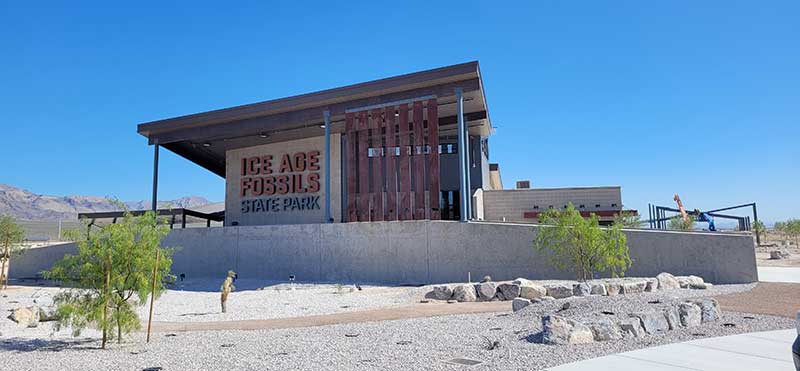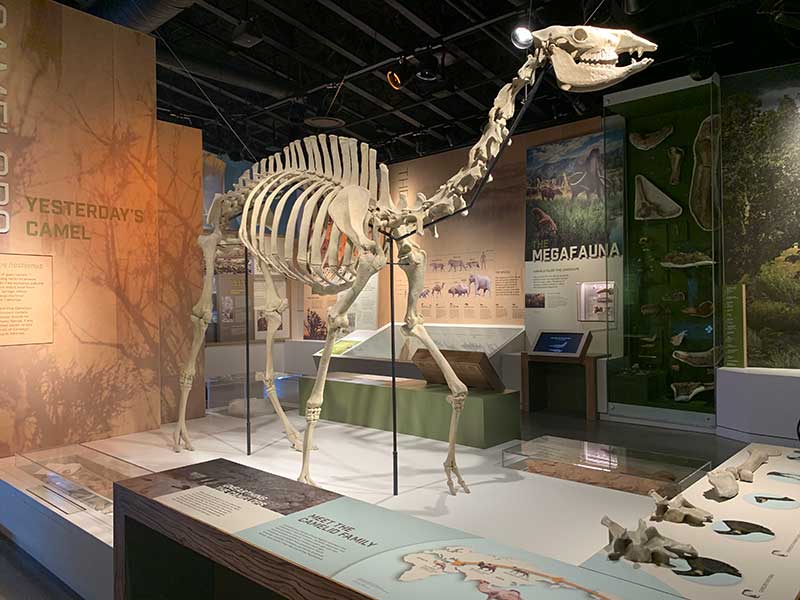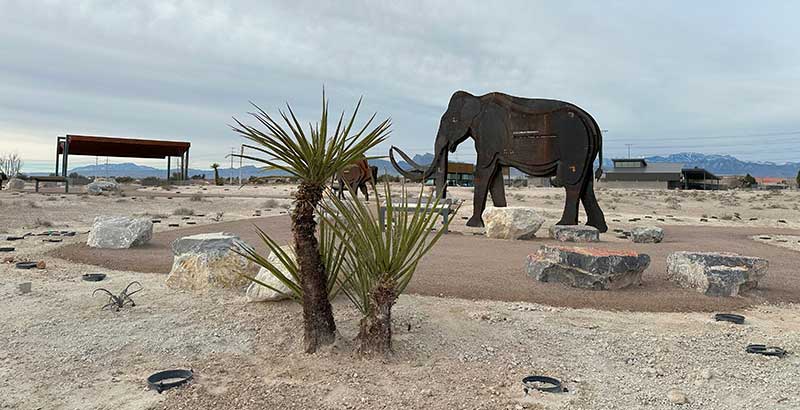
Axis deBruyn as Lord of the Lights
Before the Neon
New State Park Takes Visitors on an Informative and Entertaining Journey into Las Vegas’ Past
By Heather Turk
One of Las Vegas’ coolest new attractions invites visitors to step back in time to when Las Vegas was wet and green, and herds of large herbivores like ancient bison and Columbian mammoths roamed the land.
Located just 20 minutes north of the Las Vegas Strip, Ice Age Fossils State Park opened to the public this past January. Although construction started in 2018, the 315-acre state park was nearly 25,000 years in the making.
“Ice Age Fossils State Park stands out as a unique and educational destination amidst the city’s renowned entertainment and nightlife,” said Tyler Kerver, education and information officer for the Nevada Division of State Parks’ conservation and natural resources department. “This park offers an enriching experience, allowing visitors to delve into the prehistoric past and learn about the ancient animals that once inhabited the region during the Ice Age. Beyond its educational significance, the park provides a tranquil outdoor environment for activities like hiking and exploration, offering a refreshing escape from the urban hustle. For both locals and visitors, the park contributes to the preservation of natural heritage, fosters scientific curiosity, and adds a distinctive layer to the diverse attractions of Las Vegas.”

The “Monumental Mammoth” sculpture is a prominent feature of Ice Age Fossils State Park. Photo by Heather Turk
Costing nearly $14.4 million, Ice Age Fossils State Park boasts a $4 million visitor center where guests can learn more about the ancient and modern-day history of the North Las Vegas attraction. Visitors can see a full-size Camelops skeleton replica on display, play interactive fossil games, and watch a 10-minute video about the park, all while learning about the study of paleontology and the megafauna that lived in the area. Several fossils are also showcased, all found in the park between the 1990s and early 2000s when the last major fossil dig took place on its grounds.

Even though the springs have dried up, the Las Vegas Wash Trail is still home to colorful flora. Photo by Heather Turk
While guests will see such interesting items on display as a 7-and-a-half-foot tusk that came from a Columbian mammoth that lived on the land around 14,500 years ago, arguably the most fascinating part about Ice Age Fossils State Park is the nearly 4 miles of trails found just outside the visitor center. Guests can view metal sculptures of the megafauna species that once roamed the grounds, including Shasta ground sloths and saber-toothed cats, on the .3-mile Megafauna Trail; see lush vegetation while descending into a wash and strolling through 100,000 of geologic history on the 1.5-mile Las Vegas Wash Trail; and walk around the famous Big Dig area and through part of the historic Trench K site on the 1.2-mile Big Dig Trail.

Hike part of the longest trench cut during the Big Dig, Trench K, on the Big Dig Trail. Photo courtesy of Nevada State Parks
Undoubtedly one of Las Vegas’ most unforgettable experiences, the Big Dig Trail takes hikers through part of the 1962-63 Tule Springs Expedition. The four-month-long study brought in researchers from a variety of fields who used heavy equipment and cutting-edge technology, including the new technique of radiocarbon dating, to try to prove that the earliest humans in North America inhabited Tule Springs. Pockets of black material resembling charcoal, sometimes mixed with the blackened bones of megafauna species, were found on site in 1933. In 1954, additional charcoal samples collected in the area were radiocarbon-dated. The samples, believed to be 23,800 years old, would make Tule Springs the oldest archeological site in North America, potentially rewriting the story of human migration into the Americas.
Although the Big Dig could not verify claims of a human presence in the area beyond 13,000 years ago, researchers returned to Tule Springs in the late 1990s and early 2000s to study its fossil history and geology. Hundreds of fossil sites were discovered around the springs, expanding the public’s understanding of what Las Vegas was like during the Ice Age. While on the Big Dig Trail, visitors will not only hike past what was once believed to be the site of the oldest campfires, which eventually led to the Big Dig expedition, but also hike past Dire Wolf Hill, where, nearly 50 years later, students from UNLV discovered a dire wolf knuckle bone—the first discovery of the species in Nevada.

One-third of all the large mammal fossils found at Ice Age Fossils State Park came from the now-extinct Camelops. Photo by Heather Turk
Guests will also pass by researchers’ campsites and the canyon where paleontology students unintentionally rediscovered a site from the Big Dig while excavating a mammoth tusk in 2011. Surrounding the tusk were scraps of newspaper, one of which had a print date from 1963, showing that the tusk had been partially excavated during the Big Dig. Visitors can now see the 3-and-a-half-foot tusk on display inside the visitor center and a small piece of the newspaper it was found in.
While none of Ice Age Fossils State Park’s three trails are extremely challenging, the Las Vegas Wash Trail and the Big Dig Trail are rocky and involve several steps at points, making them inaccessible to wheelchairs and strollers. The Megafauna Trail, though still unpaved, is a bit more family-friendly. None of the trails have much shade, so hikers are strongly encouraged to bring lots of sunscreen and water to stay hydrated.

The metal animal sculptures on the Megafauna Trail are a big hit with children visiting the park. Photo courtesy of Nevada State Parks
Since Ice Age Fossils State Park is a historic paleontological site, fossils are still discovered in the park and can sometimes be viewed from the trails. Guests should make sure their camera phones are charged so they can take plenty of photos. There is also a sculpture near the park entrance where visitors can take pictures with the “Monumental Mammoth.” The sculpture, made of steel and recycled materials, was the idea of Las Vegas Girl Scout Tahoe Mack, who envisioned constructing a life-sized Columbian mammoth using materials collected from the grounds and various other sites around the park during public clean-up efforts. While the sculpture now stands as a symbol of Nevada’s Pleistocene past and the importance of protecting the Tule Springs fossil beds, it was previously on display in 2019 at Burning Man and downtown Las Vegas’ Life is Beautiful festival.
Ice Age Fossils State Park is open Wednesday through Sunday from 8 a.m. until 4:30 p.m. Each guest must pay a $3 admission fee, which can be paid in the visitor center right next to the gift shop. Visitors will want to give themselves at least 3 hours to explore the trails and visitor center, so be sure to plan your trip accordingly and factor in some extra time if you want to take advantage of the covered picnic areas on the grounds to have lunch. Regardless of how long you stay at the park, you’re sure to leave with a newfound appreciation of Nevada’s natural history.
For more information, visit parks.nv.gov/parks/ice-age-fossils.


